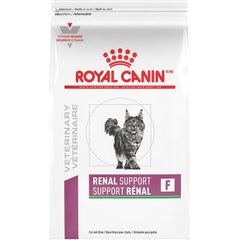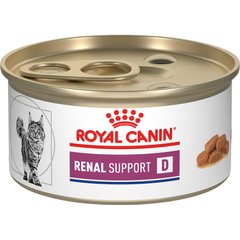Kidney Disease in Cats: Signs, Causes, and Treatment
iStock/Phynart Studio
Kidney disease is one of the most common diseases in cats, and the chances of it occurring increase as the cat gets older.
There are many causes of kidney disease in cats, including injury to the kidney, hereditary conditions, and underlying medical conditions.
Early detection and treatment are key to providing the best chance for cats to live longer with a better quality of life.
Key Takeaways
- Kidney disease in cats is common, especially in senior cats.
- Kidney disease can be caused by underlying medical conditions, acute injury, or genetic disorders; however, in many cases the cause is unknown.
- Common symptoms of kidney disease in cats include decreased appetite, increased thirst and urination, lethargy, and vomiting.
- Kidney disease in cats can be managed with medications, diet, and hydration.
What Is Kidney Disease in Cats?
A cat has two kidneys, one on each side of the abdomen, and they play a vital role in filtering waste from the body. Additionally, the kidneys serve to regulate the body’s balance of fluids, minerals, and electrolytes. They conserve water and protein and play an important role in maintaining blood pressure and red blood cell production by making a hormone called erythropoietin.
There are different types of kidney disease in cats and various underlying causes. Many of these conditions are progressive in nature and debilitating, which can be life-threatening.
When enough damage has occurred (losing about two-thirds of kidney function), signs become apparent and regeneration will not occur, leading to chronic kidney disease.
Chronic renal failure (CRF), renal insufficiency, and chronic kidney disease (CKD) are medical terms used interchangeably to describe the same condition.
Causes of Kidney Disease in Cats
Feline kidney disease can be caused by a variety of factors:
-
Injury to the kidney: For some cats, the disease could have occurred after a serious kidney injury; from a severe infection (including feline infectious peritonitis, toxoplasmosis, and pyelonephritis); ingestion of a toxic substance (like antifreeze, lilies, or rat poison); and from certain medications (like NSAIDs for people, such as acetaminophen or ibuprofen).
-
Hereditary: For others, it could be inherited, as with polycystic kidney disease (a specific type of renal disease in cats) and amyloidosis, a rare organ disease seen primarily in Abyssinians.
-
Underlying medical condition: It could also be attributed to underlying immune-mediated diseases, stroke-like events, clotting disorders, heart disease, and even cancers like lymphoma.
Even with the best testing, in some cases, the underlying cause remains unknown.
Symptoms of Kidney Disease in Cats
So, what does cat kidney disease look like?
Clinical signs of kidney disease in cats are often related to the severity of the kidney disease and underlying cause. Most cats will exhibit symptoms including:
-
Changes in frequency of urination or inability to urinate
-
Foul breath (usually an ammonia-like odor)
-
Weight loss
-
Muscle wasting
-
Changes in body temperature (fever or, in late stages, hypothermia)
-
Edema (fluid-filled swelling in the limbs)
-
Changes in behavior (such as hiding, decreased activity, or acting aloof)
Health Tools
Get quick answers with our vet-created Symptom Checker
How Veterinarians Diagnose Kidney Disease in Cats
Kidney disease is often diagnosed based on routine blood work and a urinalysis, looking specifically at such kidney markers as:
-
Blood urea nitrogen (BUN): This is a by-product of protein metabolism. Higher values may indicate kidney failure.
-
Creatinine (CREA): Measuring the amount of creatinine, a waste product indicates, how well kidneys are filtering waste from blood.
-
Phosphorus: Elevated phosphorus levels typically indicate kidney failure.
-
Electrolytes: Sodium, potassium, and chloride are often affected by the primary disease—but also by secondary factors, such as vomiting and a lack of appetite.
-
Calcium: Elevated levels, though not as common, are often seen as the disease advances.
-
Red blood cell count: Anemia, low red blood cell count, may indicate kidney failure.
-
White blood cell count: If high, it may indicate infection or inflammation.
-
Symmetric dimethylarginine (SDMA): Measuring for this amino acid is an additional test to help determine if kidney disease is present. It can be used for early detection of kidney disease.
-
Urine specific gravity: This is a marker of how diluted or concentrated the urine is. Usually, the lower the number, the more diluted the urine. This may indicate kidney disease, since a healthy kidney should be able to resorb water to concentrate urine to prevent dehydration.
-
Urine sediment: These are microscopic solids in the urine that are checked for bacteria, white/red blood cells, crystals, epithelial cells and casts. Certain cells and casts can indicate kidney damage. Bacteria and white blood cells indicate infection.
Your veterinarian will most likely recommend additional diagnostic testing, including:
-
A urine protein to creatinine (UPC) ratio to quantify how much protein is being lost in the urine.
-
A urine culture, because cats with CKD are more likely to acquire urinary tract infections.
-
A blood pressure evaluation to determine if high blood pressure can be a cause or manifestation of kidney disease.
-
Radiographs or abdominal ultrasound to screen for kidney stones, infarcts (areas of dead tissue), and cysts.
-
A kidney biopsy to determine the type of glomerular (filtering unit of the kidney) disease present.
-
A thyroid panel to rule out hyperthyroidism. Kidney disease, hyperthyroidism, and high blood pressure frequently occur together in older cats.
Once diagnosed, feline kidney disease is then classified into four stages based on the severity of clinical signs and laboratory values:
-
Stage I: Clinical signs are usually not apparent
-
Stage II: Some clinical signs are noted
-
Stage III: Many clinical signs are noted, and cats often appear to feel sick
-
Stage IV: A majority of clinical signs are noted, and cats often present in crisis
Treatment of Kidney Disease in Cats
Kidney disease is managed mostly with the aid of medications, diet, and hydration. Specific management is geared toward the underlying cause (if known) as well as the stage of the disease.
A cat in any stage with an increase in either UPC or high blood pressure will most likely be treated with medication.
Based on the cause, additional therapy may be instituted, such as:
-
Aggressive IV antibiotics, if infection is present
-
Deworming medication for parasites
-
Immunosuppressive-type drugs for auto-immune diseases
-
Antithrombotics (to prevent blood clot formation)
-
Chemotherapy and/or surgery (if cancer is part of the underlying cause)
If a urinary obstruction is noted, relieving the obstruction would be the treatment of choice.
Throughout your cat’s life, any disease process or illness that could affect hydration should be treated promptly with IV fluids. Drugs prescribed in the future for any other disease process will need to be tailored or substituted for a more kidney-friendly alternative, given that kidney metabolism will be decreased. If not, overdosages and/or worsening of the kidney disease could occur.
Additionally, for all stages of kidney disease, fresh water should always be available. Drinking should be encouraged and adequate nutrition should be given daily.
Cats diagnosed with kidney disease are often prescribed a therapeutic renal diet, like those in the Royal Canin Veterinary Diet kidney support range. Available only with your vet’s approval, these diets typically are formulated with lower amounts of high-quality protein and low phosphorus levels to help reduce the level of waste products in the bloodstream.
To help with hydration, your vet may recommend feeding your cat canned, wet foods that contain additional water, such as Royal Canin Veterinary Diet Adult Renal Support D Thin Slices in Gravy Canned Cat Food.
Recovery and Management of Kidney Disease in Cats
Cats diagnosed early on with kidney disease will benefit from nutritional management and more frequent veterinary attention, which may include more regular checkups and blood work.
Cats in stages I and II may often be monitored for further progression of signs, and some may be given a therapeutic diet specifically geared to help the kidneys by limiting the amount of work they have to do.
Many cats can go on to have a decent quality of life for many months or years, depending on the specific diagnosis.
Cats in stages III and IV often require more medical and dietary assistance:
-
If secondary anemia is present, erythropoietin injections or an oral medication called Varenzin-CA1 can be given at the direction of your veterinarian.
-
Dietary supplements may be prescribed to help with hypokalemia (low potassium).
-
Phosphorus binders may be prescribed to treat high phosphorus levels.
-
Anti-nausea, anti-emetic (anti-vomiting), or appetite-stimulating medications can be given to cats with nausea, vomiting, or poor appetite.
-
Fluids given either intravenously or underneath the skin can help with dehydration, and your veterinarian can show you how to administer these fluids at home.
-
Medication to lower blood pressure, such as Semintra, may be prescribed if the cat has hypertension.
Because of the severity of signs often seen in cats in stages III and IV and the amount of care and effort required to support these cats, some may be humanely euthanized.
Prevention of Kidney Disease in Cats
Some causes of kidney disease may be preventable (such as toxicologic causes), but unfortunately, most causes are not. Heritable conditions, for example, are not preventable, but affected cats, or cats with the genetic copies of the disease, should not be bred.
To limit your cat’s exposure to toxins, keep lilies out of the home and block off access to the garage, household cleaners, and medications. Limiting exposure to stray cats who may be carriers of disease, like FIP, that could cause kidney disease, as well as keeping your cat up to date on vaccines and monthly heartworm and flea control is recommended.
Be sure to schedule wellness exams that include blood and urine testing, especially for senior cats.
If you notice any of the above signs of kidney disease in cats, take your cat to a veterinarian for examination as soon as possible. Early diagnosis and intervention are keys to maintaining quality of life.
Kidney Disease in Cats FAQs
What is the life expectancy of a cat with kidney disease?
The life expectancy of a cat with kidney disease varies depending on the underlying cause and the stage at which the disease is diagnosed. Cats in the earlier stages are more likely to live longer if the underlying disease is treated appropriately.
Are cats in pain with kidney disease?
Some urinary issues, like obstructions and infection, are painful and can lead to kidney disease. End stage kidney disease can be debilitating, and cause a poor quality of life.
Can a cat recover from kidney disease?
Some cats that experience acute kidney trauma can recover, although there may be long-term effects that can lead to chronic kidney failure.
Cats in chronic kidney failure will not recover, as it is not curable. However, depending on the stage of kidney failure they are in when diagnosed, their lab values, and how well they respond to treatment, some cats can go on to live a relatively normal life, with some lifestyle changes and long-term management.



